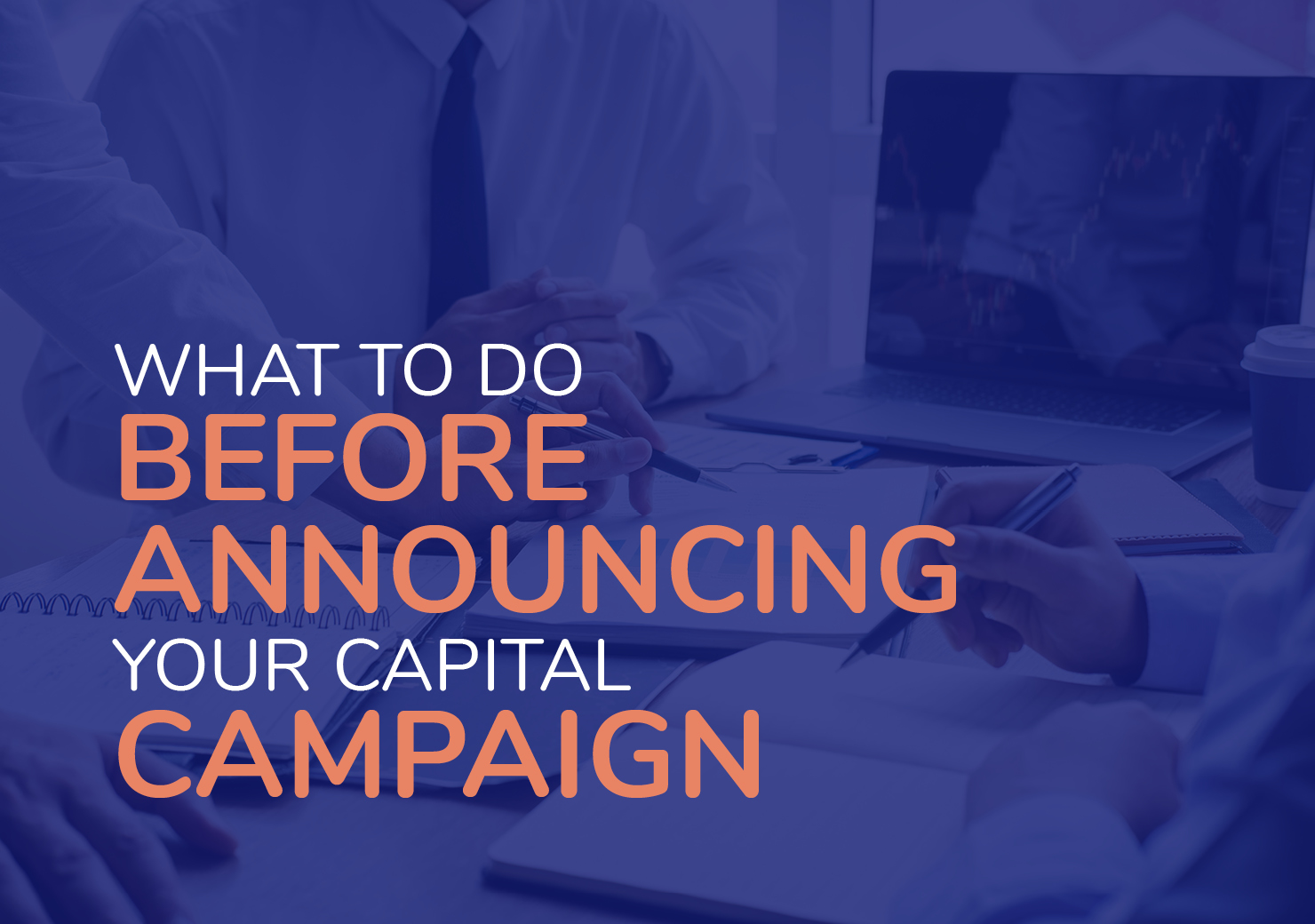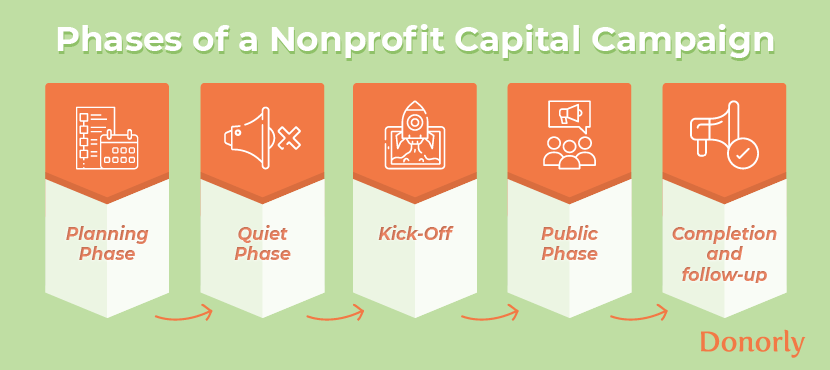4 Things to Do Before Announcing Your Capital Campaign

If your nonprofit is in the early phases of a capital campaign, you may be wondering exactly how long this period should last. You’ve already set your fundraising goal, done initial prospect research, and solicited a few major gifts from board members and major donors. How much longer do you need to wait before you announce your capital campaign to the public?
The answer isn’t always straightforward. The quiet phase of your nonprofit’s capital campaign should last as long as you need in order to be ready for a public campaign kickoff, which can vary widely from organization to organization. At a minimum, you should do four things before telling the world about your capital campaign:
- Perfect Your Case for Support
- Raise 50-70% of Your Fundraising Goal
- Develop a Marketing Strategy for Your Public Campaign
- Plan a Campaign Kickoff Event
Taking these steps ensures that you’re prepared to present your campaign to the public in the best light possible, helping you garner the remaining support you need to reach your goal.
1. Perfect Your Case for Support
By this point, you’ve already developed a case for support to share with prospective major donors that outlines goals, resources, and projected outcomes for your campaign. Now, it’s time to take another look at it to make sure the document has evolved with your campaign and is ready for the public eye.
Follow these steps to polish your case statement before you release it to the public:
- Incorporate any feedback you’ve gotten from initial prospects and donors.
- Perfect your storytelling strategy based on the tactics that have resonated most with donors so far.
- Add any additional information you now have, such as an adjusted construction timeline for your building.
- Update your fundraising goals if they’ve changed throughout the course of your campaign.
Additionally, NXUnite recommends adding compelling visuals to your case for support if you haven’t already. This could include renderings of the building you want to construct, photos of volunteers lending their support, or infographics that help donors visualize your goals and progress.
Along with providing your case statement to prospective donors to secure their support, this document will be instrumental in crafting marketing materials for the public phase of your campaign. Using this document as the basis, you can build out campaign brochures, blog posts, and social media content that articulates your nonprofit’s vision.
2. Raise 50-70% of Your Fundraising Goal
Next, it’s essential to understand which phase of your capital campaign you’re in and meet the goals of that phase before moving on to the next. The basic phases and goals of each one are as follows:

- Planning Phase: Conduct a feasibility study, set fundraising goals, and plan your capital campaign.
- Quiet Phase: Cultivate prospective major donors and earn most of the campaign’s funding by soliciting major gifts.
- Kickoff: Announce your capital campaign to the public and celebrate with a kickoff event.
- Public Phase: Raise the remainder of the funds needed to reach your campaign’s fundraising goal.
- Completion and Follow-Up: Wrap up the campaign and thank everyone involved for their support.
Right now, you’re likely in the planning or quiet phase of your campaign. According to Donorly’s guide to capital campaign planning, you shouldn’t move out of the quiet phase until you’ve raised at least 50-70% of the funds needed to reach your total campaign fundraising goal.
Raising this much funding can take multiple years, so don’t worry if you’re a year or two into your capital campaign and haven’t announced it to the public yet. The quiet phase is the most important part of a capital campaign—so taking your time is a good thing! Focus on building relationships with major donors until you can secure enough funding to confidently move on to the kickoff phase.
After reaching 50-70% of your goal, consider how you’ll raise the remaining 30-50% through additional major, mid-level, and small donations. If you haven’t already, create a gift pyramid that outlines how many donations you’ll need at each level to reach your goal. For example, you might need ten $1,000 gifts, four $5,000 gifts, and two $10,000 gifts to obtain the $50,000 you still need to raise.
3. Develop a Marketing Strategy for Your Public Campaign
Once you know you’re financially ready to move forward, design the marketing strategy you’ll use to publicly announce and promote the remainder of your capital campaign. Think about how you’ll make the initial announcement, advertise the kickoff event, and maintain momentum until you reach your goal.
Use a variety of communication channels to reach mid-level and smaller donors within your general audience, such as:
- Your website: Create a landing page for your capital campaign that includes information about your vision and goals and explains how to donate. Then, link to this page in your site’s navigation bar, your homepage, and other marketing materials on different channels.
- Email: Use donor segmentation to group supporters based on shared interests and involvement in your organization, then send emails tailored to each segment. This will increase the relevance of your emails for each supporter, making them more likely to give.
- Social media: Your organization’s social media profiles are great places to post progress updates, photos of beneficiaries, and behind-the-scenes videos of your work on the campaign. Just make sure to engage with followers by responding to comments and questions.
- Text messages: While major and mid-level donors warrant carefully planned and personalized fundraising appeals, you can engage plenty of small donors just by sending a quick text appeal.
You can also get creative with your marketing to grab supporters’ attention and appeal to them in new ways. For example, you might send eCards to invite supporters to your campaign kickoff event to ramp up excitement.
4. Plan a Campaign Kickoff Event
Finally, it’s time to plan the public event you’ll use to kick off your campaign in the eyes of the community.
Kickoff events commonly take the form of groundbreaking ceremonies, formal galas, or press conferences, but you can announce your campaign in any way that makes sense for your nonprofit. Just make sure to align your kickoff event with your campaign itself and your nonprofit’s audience.
As you plan your kickoff event, make key decisions about the event’s:
- Format: Will the kickoff be in person, hybrid, or virtual? If most of your supporters live locally, an in-person or hybrid event may work best. If your donors are spread across the country or you’re targeting a wider audience, consider going virtual to allow more people to attend.
- Theme: Choose an event theme that fits with your vision for the overall campaign. For instance, you might host an environmentally-themed garden party to celebrate the kickoff of your campaign to build a more sustainable program facility.
- Volunteer needs: How many volunteers will you need to run the event? If it’s a more involved event like a gala or auction, make sure to recruit volunteers well in advance so you have enough time to train them.
You should also plan to recognize a few top donors at the kickoff event to thank them publicly for their generous support. This recognition will help sustain your important major donor relationships and show prospective donors that you genuinely appreciate your supporters.
Once you’ve taken these steps, confer with your capital campaign chair, board members, and nonprofit leadership to confirm that this is the right time to announce your campaign to the public. Then, enjoy the campaign kickoff and celebrate all the progress you’ve made!


